Questions and Answers: July 2014
Here are Neil’s answers to this month’s questions from our readers. Note that you must include a photo with the question if it is to be used here. It really helps if you’ll also include the city in which you garden. Neil chooses those questions that he feels will be of interest to most readers, so be forewarned that plant ID questions seldom make the cut. Please send Neil your question and photo here, then watch the next issue of e-gardens for his reply.
Question: We have five Leyland cypresses in a row, each about 20 feet tall. They are browning from their trunks coming out. I checked for spider mites and found no signs of them. Everything I read about diseases on the Internet is very confusing. What might this be, and how can we save them? L.H., Henderson.
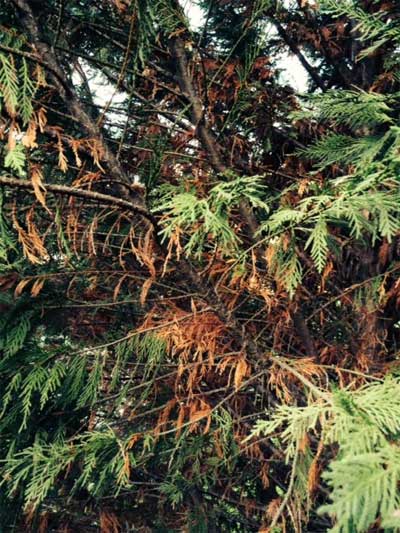
Answer: I worry that this might be Seiridium canker. It’s a common problem with Leyland cypress, and it’s usually fatal. During the brutal summer of 2011, probably 50 to 70 percent of the Leyland cypress plants I saw in my vicinity (DFW) died from it. You could see the black ooze on the trunks and branches as the disease was developing. I am not aware of any fungicide that will stop its spread. I wish I had better news. This is just not a good tree. That all said, I would still get confirmation, either by having a certified arborist stop by to look at the problem, or by having a sample run through the Plant Disease Diagnostic Laboratory at Texas A&M. Good luck with your plants!
Question: What might be wrong with my Traveler tomato plants, also the potato leaves? V.R., no city given.
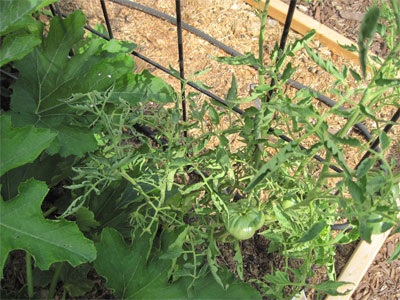

Answer: I’m going to give these two my best guesses, but that’s about all they will be. The tomato leaves look a great deal like broadleafed weedkiller damage. If you happened to apply any type of 2,4-D product within 50 to 100 feet of the plants, that could account for both problems. Tomatoes are especially susceptible. Tobacco mosaic virus is another less likely possibility. Chili thrips might be involved with the potatoes and perhaps even with the tomatoes. I’ve not experienced them personally. They are a comparatively new insect pest to Texas. Perhaps somewhere in there you’ll find a nugget to help you.
Question: What would cause a tomato plant to wilt very quickly? It was lovely one day. We had a great rain, and the next day it was wilted and gone. B.H., Pittsburg.
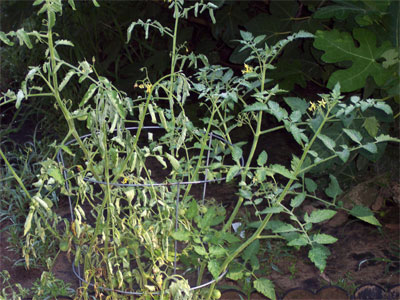
Answer: I spoke in Texarkana three weeks ago, and we came down through your area. Obviously, you had many nice rains this spring and early summer. This happens to tomatoes when they sit in waterlogged soils for more than a few hours. In fact, you’ll usually see roots trying to grow out of the main stems of the plants when this is happening. Those are called adventitious roots, and they’re the plants’ reaction to root loss due to poor drainage. You might elevate the planting bed 4 or 5 inches above the surrounding grade to ensure good drainage.
Question: I have three red maples trees (3 years old) that have not done well. It looks like iron deficiency, so I have applied an iron supplement, but it has not helped. What might have caused this? D., Salado.

Answer: I really think your diagnosis is correct. The problem is that the soil in Salado is extremely alkaline. Any northern tree that requires iron is going to react this way, given time. You would be better off planting a Caddo or bigtooth maple. Talk to a local independent retail garden center in your area.
Question: My Frostproof gardenia made it through last summer, and it made it through the winter. Now, as growing conditions have improved, it’s going downhill rapidly. It gets sun from 11 until 3 daily. What is the cause? J.A., Gregg County (Longview area).
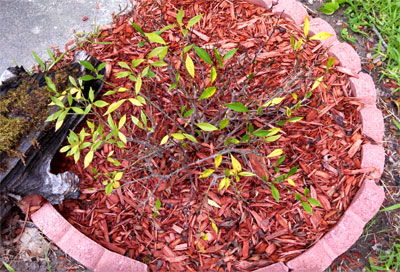
Answer: I would begin by adding a liquid fertilizer with a high percentage of nitrogen. This is not iron deficiency, but the problem could be due to some type of moisture stress, and I wouldn’t entirely rule out latent cold damage. Unfortunately, it’s hard to tell just from yellowed leaves. I suspect the problem is in the stem or roots.
Question: The crown of this plant has died for no apparent reason. What might have happened? B., no city given.
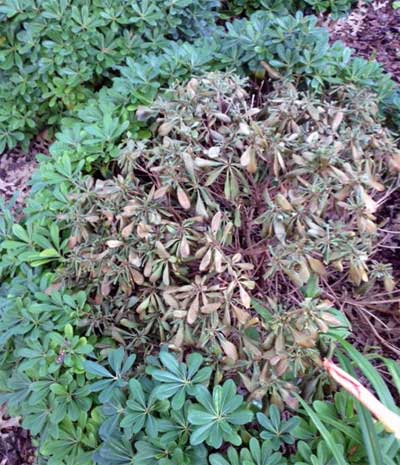
Answer: This is Wheeler’s dwarf pittosporum. I’ve been around pittosporums almost all of my life, and I have never seen an insect or disease do harm to them. However, cold can ruin them quickly. If I only knew where this plant is in Texas, I could give you a better answer. The only other thing that might cause this would be mechanical injury, in which case you should be able to see a broken stem or trunk.
Question: We own a lot on which we hope to build our retirement home. Unfortunately, the lot has a great deal of poison ivy beneath trees. Is there a safe alternative that can be used near trees? All the products I find warn against possible damage. R.J., no city given.

Answer: Try a local independent retail garden center, and ask for a product containing only 2,4-D as its active ingredient. You’ll still want to be precise in how you apply it, but 2,4-D is not active in the soil. As long as you spray it directly onto the poison ivy and do not do so when it’s windy, you’ll be fine. I eliminated several acres of it beneath our pecan trees without any damage.
Question: Should I cut the small roots on my live oak before they grow into the one larger root? M.S., Rockwall.
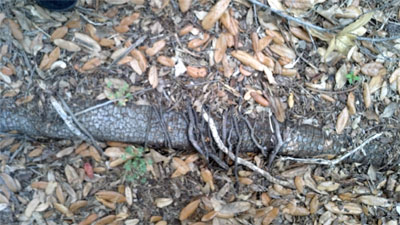
Answer: Yes. As they get larger, they will girdle the larger root – not a good thing.
Question: We have three rose bushes that don’t look very good. Their leaves are sparse, and the plants are stemmy. We had two heavy rains a couple of weeks before this photo was taken. What advice do you have? C., Somerville.
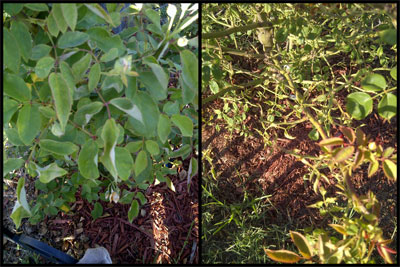
Answer: The close-up of the leaves shows powdery mildew. That’s the silvery dusting that you see on the leaves. It causes the puckering. I don’t see any black spot in the photos, but it usually travels hand-in-hand with powdery mildew, and it can certainly lead to bare stems. You probably will want to spray them with a labeled fungicide every 7 to 10 days in spring or fall. Or switch over to Earth Kind® roses — those identified by Texas A&M research to be almost bullet-proof.
Question: Vine shoots are taking over my yard. I believe it’s a trumpet vine that used to grow over my pergola. It became unmanageable, and I took the mother plant out. Now there are shoots coming up all over the yard. What can I do? R.S., Plano.
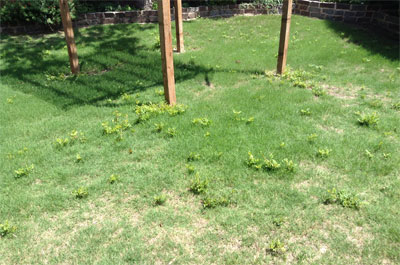
Answer: Yes, these are trumpet vines. The wild species root-sprouts abundantly. Drill into the stump of the mother tree to make pinkie-sized “reservoirs” within the wood. Pour the reservoirs full of a broadleafed weedkiller product at full strength. Let it soak into the wood to kill out the roots that are giving rise to the sprouts. Apply the same broadleafed weedkiller product, but this time at the diluted spraying strength and as a spray directly onto the actively growing root sprouts. It may take a year to get rid of all of them, but you can do it!
Question: My 6-year-old yaupon tree always drops leaves in the spring, but this year it seemed worse than usual. Some of the lower leaves are bare now. I’m concerned about the tree’s health. Do you see anything I should do to stop the yellowing and leaf drop? S.B., no city given.
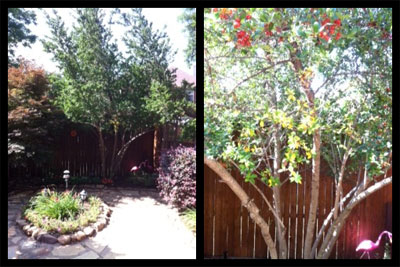
Answer: The new growth at the top of the plant tells us that it’s growing vigorously, so I don’t think there is any reason for concern. The leaf drop you show looks fairly normal. It was probably just more abrupt this year than it has been other years. Whether old leaves drop over a two-week or four-week period will vary from year to year. The fact that you have bare lower branches can easily be traced to all the shade the tree gets down there, both from adjacent plants and from the fence. If I were to suggest anything, it might be to do some selective pruning to the top of the plant to even up some of the strongly vertical shoots that are developing there.
Question: My tomatoes are lacking blooms and tomatoes. I have added phosphorus, and they are beginning to bloom. I have 50 plants. Celebrity, BHN 444 and, I believe, BHN 649. Help? T.D., no city given.
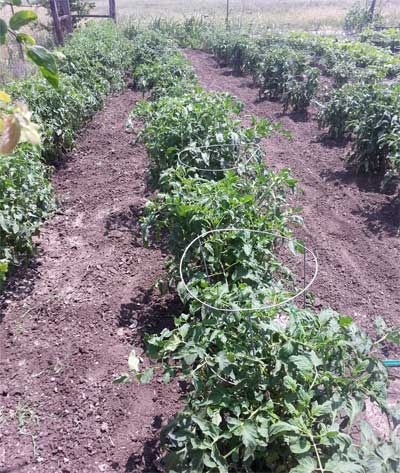
Answer: Lovely plants, and hopefully in the days since you sent your note they have started blooming and setting fruit well. Phosphorus shortage might have been the culprit, but Texas A&M’s Soil Testing Lab has been warning us for decades that most Texas soils already have too much phosphorus, and that we really should not be adding more. If you’re in a sandy soil, or if your soils test low in phosphorus for whatever the reason, you did the right thing. But I’d have it tested before you apply any more. Spring 2014 was, at best, bizarre. Many people reported ongoing issues with their tomatoes.
Question: I don’t know the name of this weed, but it’s really difficult to eliminate. It is spreading to other parts of my yard and neighbors have it as well. How can we eliminate it? O.G., Waxahachie.
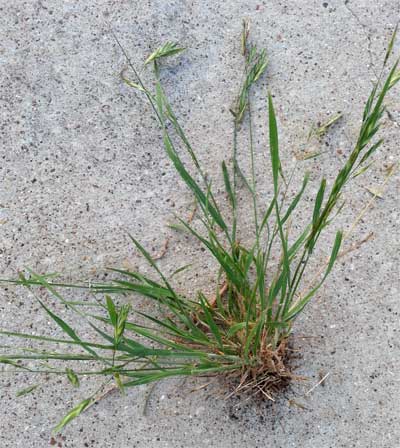
Answer: This is rescuegrass. It’s a cool-season annual grassy weed that germinates and begins growing in late September. By spring it becomes large and unsightly. Then it goes to seed and dies away until the cycle begins again in September. There are no sprays that will kill existing rescuegrass (or other grassy weeds) without killing your lawngrass. Your best and only recourse is to apply a pre-emergent weedkiller the first week of September. Either Dimension or Halts granules will prevent its seeds ever from sprouting. It also works on annual bluegrass. But if you miss that deadline time, all you can do is wait for another year.
Question: Something is eating my hostas. Bugs? Squirrels? Any advice? J.J., Arlington.
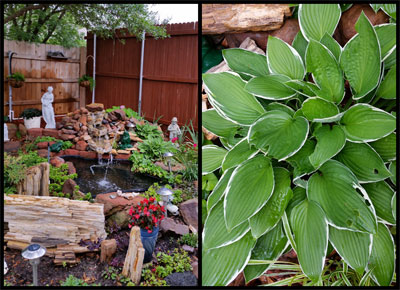
Answer: It’s actually neither insects nor squirrels. This is damage done by snails and slugs. Hostas are their very preferred food. Dust the plants and the ground with Sevin insecticide. Leave the dust in place for a couple of days, then rinse it off. You will have killed them off by then.
Question: What can I do to pollinate my cantaloupes, cucumbers, peppers and squash? We had ample bees last year, but I’ve only seen a couple this year. Our garden is 60 by 70 feet, so we’re pretty serious about it. R.H., Rhome.
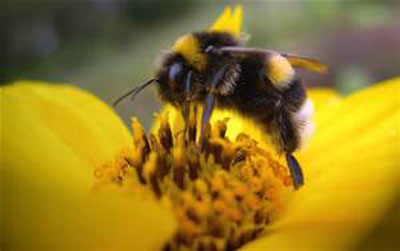
Answer: In the absence of bees, you may have to do the pollinating by hand. Learn to identify the male and female cucurbit flowers. Male flowers have straight stems, while the females have primordial fruit that are already formed in their small stems. Pluck male flowers off one squash plant, for example, and peel the petals off. Daub pollen onto the female flowers. That will work for all squash, cucumbers and other melons. Peppers are not pollinated by bees, but by mechanical agitation (wind, for example). Bell peppers, especially, may be reluctant to set fruit well in summer’s highest temperatures.
Question: We are finding strips of bark from live oak trees on the ground. Do squirrels do this? Why? Is there any way to stop it? W.W., no city given.
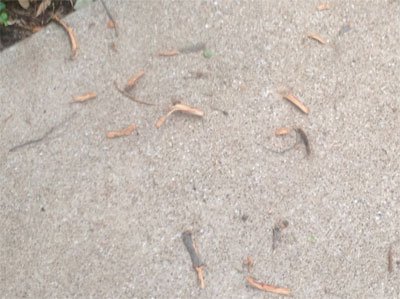
Answer: You’re right — that’s done by squirrels. Their teeth never stop growing (much like our fingernails). They peel the bark away and chew the internal wood, all as a means of keeping their teeth sharp. The trees will grow around the damage. There’s not much you can do about it anyway. No call to action.
Question: What is wrong with my squash plants? Tomatoes, too. I have a raised bed filled with mix from a reputable local supplier. I added peat moss last fall, too. D.W., Fort Worth area.

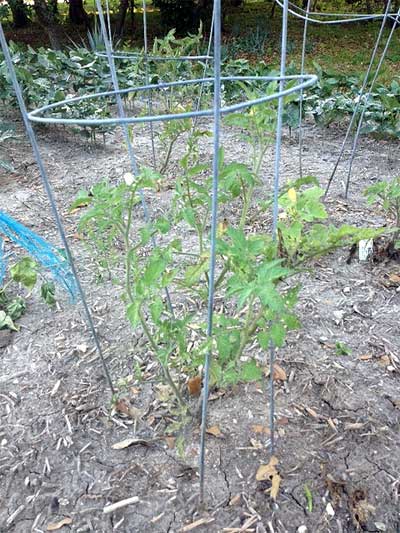
Answer: They are undernourished and underwatered. The material you bought may have had too much quickly decaying organic matter. It looks like it is tying up the nitrogen in the soil, not allowing the plants to get enough for their own needs. The planting mix looks like it needs several inches of peat moss, perhaps an inch of pine bark mulch and an inch of expanded shale to help loosen it up. Rototill all of that down 10 to 12 inches into the mix. I don’t see enough loose organic matter in the soil. I didn’t include the brand of water-soluble fertilizer that you used, but it is fine.
Question: Is this freeze damage to our crape myrtles? S.G., no city given.
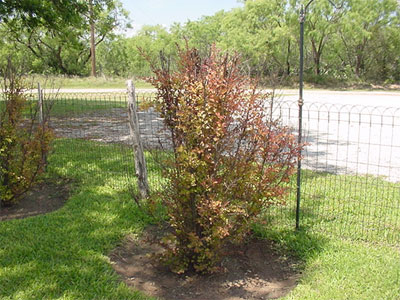
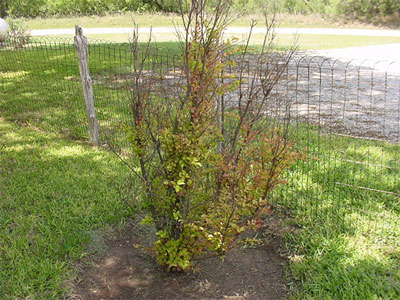
Answer: Yes. We’ve seen a lot of this this spring and early summer. Watch for new shoots to develop near the ground. If they do, you may want to remove most of this top growth and let the regrowth take over.
Question: Why would my Salvia greggii plants that I’ve had in my garden for four years not have bloomed at all this spring? I may have trimmed them back more than usual. J.J., Parker County.
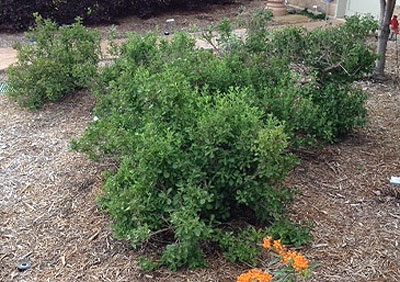
Answer: This past winter was fairly challenging to Salvia greggii varieties. That set them back, and a heavy trim would have done so as well. You’re just seeing a lot of strong vegetative regrowth. They’ll catch up on their blooming.
Question: I bought five trees last fall. I was told they were bur oaks, but they aren’t doing well, and I know you’ve said that sometimes pin oaks get mixed in with other oaks. Are these bur oaks? J., Lavon.
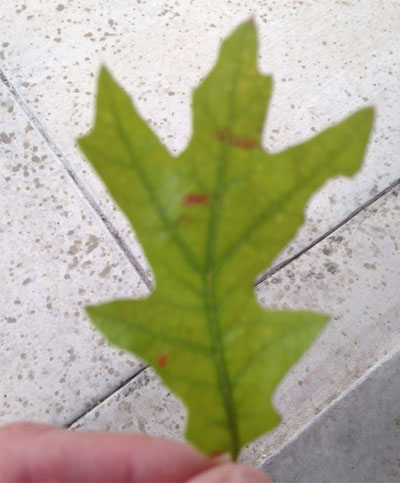
Answer: These are not bur oaks. Bur oak leaves are large and have very rounded lobes. One other difference will be that bur oaks usually have thick and fissured bark that begins to appear even while the trees are quite young. The one leaf you show in your photo does not appear to be Shumard red oak, either. (That’s the good one for areas with alkaline soil like you have.) I’m not exactly sure what it might be, but it sounds like you need to make a trip back to the nursery. Were these trees leafed out when you bought them? Are these leaves different from what you would have seen last fall?
Question: I bought a plant last fall from one of the national retailers. It had a small plant (looked the same) in the pot with it. The bigger plant died over the winter, but this one came back. Is this a willow? L., no city given.
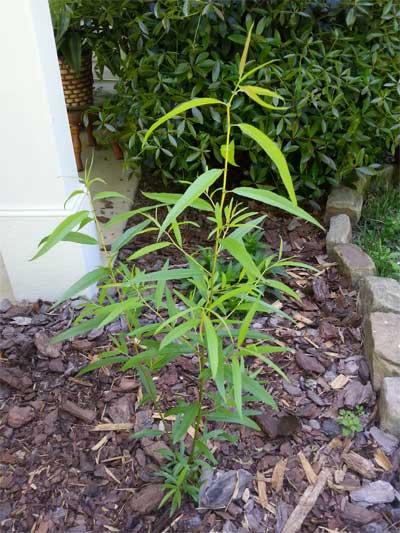
Answer: Yes. Probably black willow, the wild and weedy native tree that sends cottony seeds all over the world. If the other plant was supposed to have survived the winter, you should talk to the retailer if you think it was not healthy and vigorous at the time you bought it. This seedling was just a weed in the pot.
Question: One of my elaeagnus plants has developed a leaf curl at the top. What causes this, and what should I do? S., Lucas.
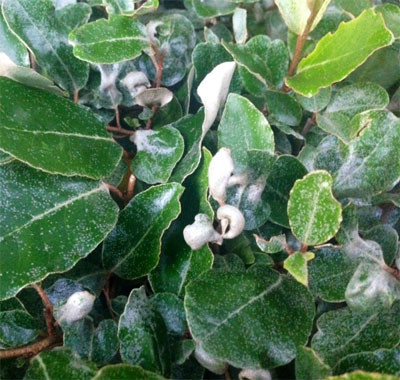
Answer: Peel one of those rolled leaves open and see if there might be an insect that has used it to build a cocoon. I have grown elaeagnus all of my life, and it’s going to come across as unprofessional for my career choice, but I have seen this before, I’ve noted that it’s there (and that it doesn’t cause any kind of real damage), and I’ve never bothered to unroll one of the leaves and peek inside. Long-term, this is not going to be an issue for your plant.

